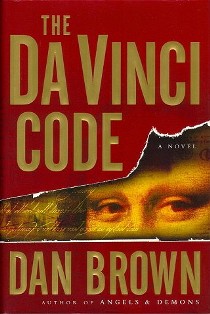
First published in April of 2003, American author Dan Brown’s hugely-successful novel ‘The Da Vinci Code’ was the author’s forth novel to see publication which launched the author into overnight worldwide success, becoming an instant best seller. The novel is the second book in the 'Robert Langdon' series, with 'Angels & Demons' (2000) first introducing the principal character and 'The Lost Symbol' (2009) following on from 'The Da Vinci Code'.
In 2005, American author Lewis Perdue filed a claim against Brown’s novel stating that it plagiarised his earlier novels ‘The Da Vinci Legacy’ (1983) and ‘Daughter Of God’ (2000). Although clear similarities were present between the books, the case (and a further appeal) were unsuccessful. Further still, Michael Baigent and Richard Leigh – authors of ‘Holy Blood, Holy Grail’ (1982) later filed their own claim against Brown, once again for plagiarism. Due to the non-fiction stance taken by ‘Holy Blood, Holy Grail’, the claim was again dismissed. Although much controversy has surrounded the novel for a number of years after its initial release, the effect has been far from detrimental for its sales. The novel has received plenty of criticism, but has remained a top seller (whether for right or wrong reasons).
The novel was later adapted into the 2006 film of the
same name starring Tom Hanks and directed by Ron Howard.
DLS Synopsis:
Jacques Saunière – a Grand Master of the Priory of Sion – is found dead; murdered during his nightshift at as a curator at the Louvre. Harvard Professor Robert Langdon (a famous symbologist) is brought into the police investigation after a note scrawled in the victim’s blood states “find Robert Langdon” as well as a strange cipher to be decrypted.
The French police already have their sights on Langdon being the murderer, but after police cryptographer Sophie Neveu deciphers the code left by the dead curator, the two head off on a search for more clues to unravel the mystery that surrounds the entire murder. A mystery that soon becomes so much bigger than they ever thought it would. A mystery wrapped up in corruption, greed and deception. A mystery with a trail of clues that these two fugitives are only just getting started on.
The true meaning behind the Holy Grail is on the verge of becoming unveiled. Secrets that have remained hidden behind Da Vinci’s masterpieces since they were first painted. Loyal and committed sects that have kept their secrets from discovery for hundreds of years will be brought to light. As well as a horrendous corruption that lies at the very heart of the Catholic Church.
This is an adventure like none other. Searching deep in history, uncovering long-buried facts and standing up to one of the greatest powers on the planet. Langdon and Neveu are about to find themselves confronted with the challenge of a lifetime. A challenge that will prove as dangerous as it is compelling. A challenge to finally unlock the truth of one of the greatest mysteries of all time...
DLS Review:
Well, Brown’s ‘The Da Vinci Code’ has certainly had its fair share of criticism over the years. Just looking at the independent reviews on some of the biggest online retailers shows the vast array of conflicting views and responses that the novel has provoked. For that alone, the novel deserves a hell of a lot of recognition.
For me the novel was very much a mixed bag. Yes, the vast majority of history was monumentally inaccurate. It’s a paint-by-numbers mystery thriller – nothing more and nothing less. You certainly shouldn’t go into the book expecting an intellectual exploration of history woven within the generally more reader-friendly fabric a fictional tale. Whether Brown thought he was doing this or not is almost irrelevant to the final outcome. It’s what we’re left with.
On the other hand, what the novel is, is a fast-paced and energy filled rollercoaster of a tale, with more mysteries to unlock and secrets to unravel than you can shake a stick at. The clichés come thick and fast, with characterisation seemingly taken out of an episode of Scooby Doo.
This is escapism, pure and simple. The storyline is as elaborate and wildly far-fetched as it’s is historically inaccurate. Let’s not judge the novel on anything but what it is to the reader. And that’s a gripping and exciting thriller with plenty of cunning (but not necessarily original) ideas.
The writing itself is certainly not of any great literary skill. It’s bold and basic, without much in the way of skilful prose. At the end of the day, it’s like a classic Shaun Hutson thriller – minus the gritty violence that is.
On the downside (once again, I’m stepping away from the whole historical inaccuracies palaver which a lot of people seem to get somewhat hung up about), the storyline does get a little tired after a while, slightly sagging in the middle, with the twists becoming more and more predictable as the novel goes on. No real depth to any of the characters also seriously hinders any connection or empathy with the reader. Instead what the tale does is deliver a storyline that just drags the reader along with the speedy pace of the plot.
So there we have it - another reader’s view on ‘The Da Vinci Code’ for what it’s worth. Personally, I enjoyed a lot of the book. It kept me gripped to the end, it kept me thinking what the next development would be and most importantly it kept me entertained throughout. So I really can’t justifiably tear the novel apart too much. I’d recommend anybody who enjoys a fast-paced and easy-to-read thriller to give the novel a go. I did, and I was glad I did.
The novel runs for a total of 359 pages.
© DLS Reviews






